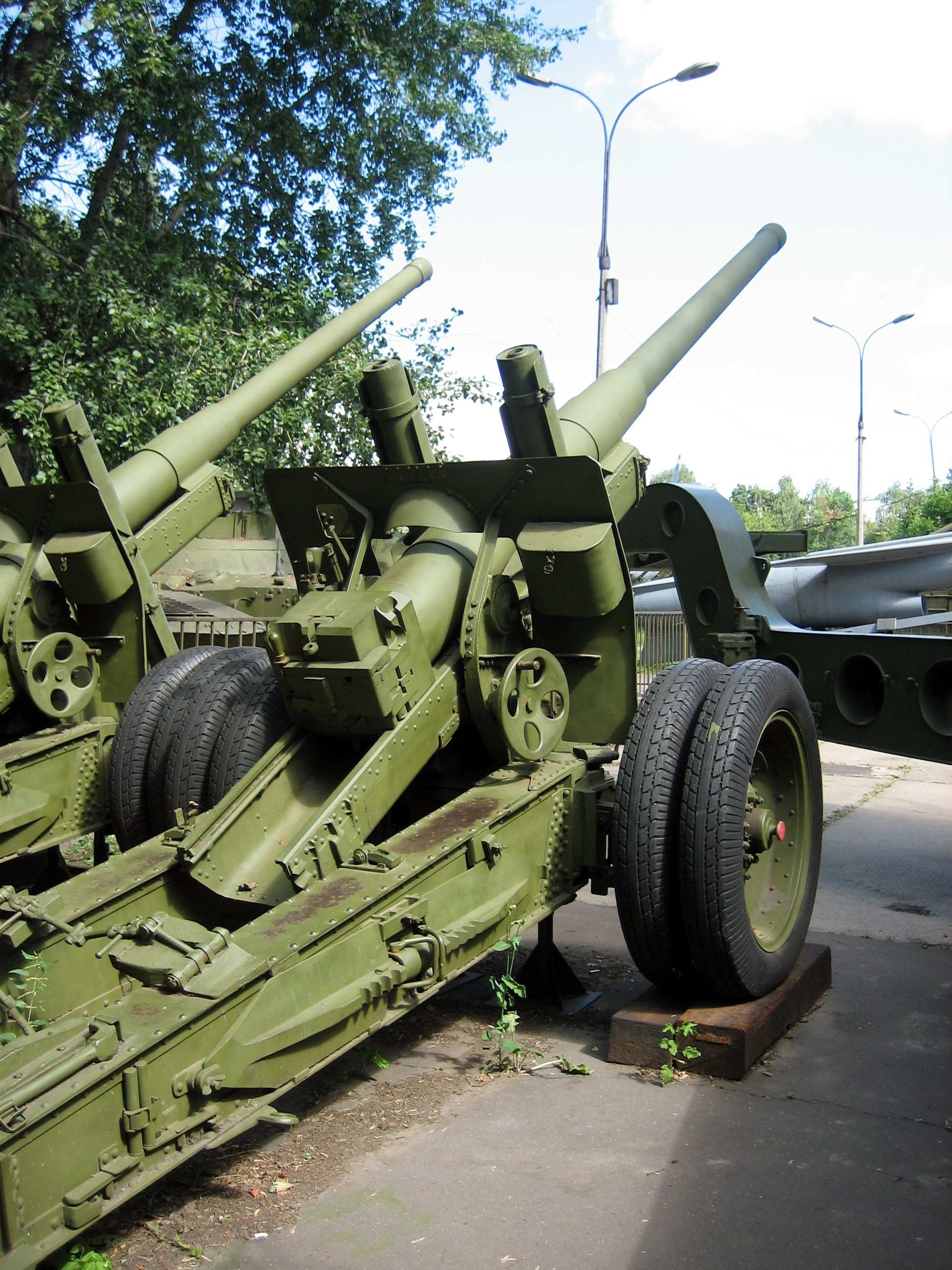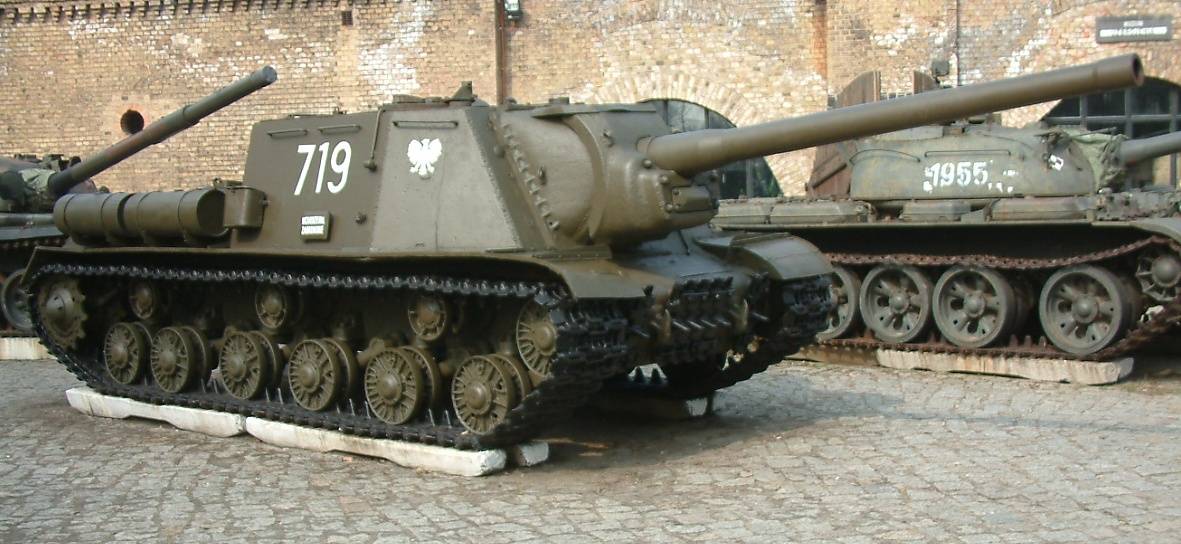|
D-25T
122 mm corps gun M1931/37 (A-19) (russian: 122-мм корпусная пушка обр. 1931/1937 гг. (А-19)) was a Soviet field gun developed in late 1930s by combining the barrel of the 122 mm gun M1931 (A-19) and the carriage of the 152 mm howitzer-gun M1937 (ML-20). The gun was in production from 1939 until 1946. It saw action in World War II (primarily with corps and RVGK artillery of the Red Army) and remained in service for a long time after the end of the war. Vehicle-mounted variants of the gun were fitted to the IS-2 and IS-3 tanks of the Iosif Stalin series of tanks and the ISU-122 self-propelled gun. Development history In 1936 the Red Army adopted the 122 mm gun M1931, also known as A-19. Unlike earlier ordnance pieces used by the Red Army, it had split trail carriage with suspension, and consequently improved mobility and traverse. The carriage of M1931 had a number of shortcomings though. The elevation mechanism was slow and unreliable; solid-tired ... [...More Info...] [...Related Items...] OR: [Wikipedia] [Google] [Baidu] |
IS-2
The IS-2 (russian: ИС-2, sometimes romanized as JS-2The series name is an abbreviation of the name Joseph Stalin (russian: Иосиф Сталин); IS-2 is a direct transliteration of the Russian abbreviation, while JS-2 is an abbreviation of the English or German form of Stalin's name.) is a Soviet heavy tank, the first of the IS tank series named after the Soviet leader Joseph Stalin. It was developed and saw combat during World War II, and saw service in other Soviet allied countries after the war. Design and production Object 237 KV-85 and IS-85/IS-1 The KV-1 was criticized by its crews for its poor mobility and the lack of a larger caliber gun than the T-34 medium tank. It was much more expensive than the T-34, without having greater combat performance. Moscow ordered some KV-1 assembly lines to shift to T-34 production, leading to fears that KV-1 production would be halted and the SKB-2 design bureau, led by Kotin, closed. In 1942, this problem was partially addres ... [...More Info...] [...Related Items...] OR: [Wikipedia] [Google] [Baidu] |
Iosif Stalin Tank
The IS tanks (russian: ИС) were a series of heavy tanks developed as a successor to the KV-series by the Soviet Union during World War II. The IS acronym is the anglicized initialism of Joseph Stalin (, '). The heavy tanks were designed as a response to the capture of a German Tiger I in 1943. They were mainly designed as breakthrough tanks, firing a heavy high-explosive shell that was useful against entrenchments and bunkers. The IS-2 went into service in April 1944 and was used as a spearhead by the Red Army in the final stage of the Battle of Berlin. The IS-3 served on the Chinese-Soviet border, the Hungarian Revolution, the Prague Spring and on both sides of the Six-Day War. The series eventually culminated in the T-10 heavy tank. Design and production KV-85 IS-85/IS-122 and IS-2 The KV-85 heavy tank was a modification of the KV-1S heavy tank. The tank was a result of the USSR's tank design bureau being torn in two, one half focusing on the KV-85 and its variants, ... [...More Info...] [...Related Items...] OR: [Wikipedia] [Google] [Baidu] |
ISU-122
The ISU-122 (acronym of'' Istrebitelnaja - or Iosif Stalin-based - Samokhodnaya Ustanovka 122'') was a Soviet assault gun used during World War II, mostly in the anti-tank role. History and purpose A prototype of the ISU-122 (in Russian ИСУ-122) heavy self-propelled gun was built at the Chelyabinsk Kirov Plant (''Chelyabinskiy Kirovskiy Zavod (ChKZ)'', Chelyabinsk, Russia), in December 1943. The design shared the chassis of the ISU-152 self-propelled gun and differed only in armament, having an A-19S 122-mm gun as its main weapon instead of the ISU-152's ML-20S gun-howitzer. Towed versions of these guns used the same carriage: 52-L-504A (Russian designation 52-Л-504А), so installation of an A-19 instead of an ML-20 gun was not a difficult task. After completing development of the ISU-152, ChKZ engineers mounted the A-19 gun on the ISU-152 chassis to create ''"Object 242"'' — the first ISU-122 prototype. It was successfully tested, but not immediately launched into mass p ... [...More Info...] [...Related Items...] OR: [Wikipedia] [Google] [Baidu] |
Komintern Artillery Tractor
The T-24 was a Soviet medium tank built in 1931. Only twenty four were built, and none saw combat. This was the first tank produced at the KhPZ factory in Kharkov, which was later responsible for the very successful BT series, T-34 and T-54 Soviet tanks. The T-24's suspension was used successfully in the Soviet Union's first purpose-built artillery tractors. The T-24's main armament was a 45 mm gun. It had a ball-mount 7.62 mm DT machine gun in the hull, another in the turret, and a third in a secondary turret atop the main turret. The tank was well-armoured for its time, but the engine and transmission had problems. Production history A tank design bureau was established at the Kharkov Locomotive Factory (KhPZ) in Kharkov, Soviet Ukraine, in 1928. The first tank project of the factory was the T-12 (or T-1-12). This was a larger version of the T-18, with a more powerful engine (the T-18 was based on the Renault FT). The idea of the T-24 tank was so great, in A ... [...More Info...] [...Related Items...] OR: [Wikipedia] [Google] [Baidu] |

